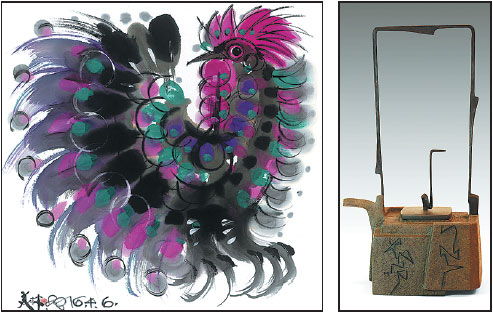Han Meilin's works show deep influence of cultural traditions
By Lin Qi (China Daily) Updated: 2017-01-03 07:54Through his six-decade career, Han Meilin - who is well-known as the chief designer of Fuwa, the good-luck mascots for the Beijing Olympic Games in 2008 - has always turned to Chinese cultural traditions for inspiration.
The 80-year-old began traveling to towns and remote villages in 1977 where he discovered folk arts, such as paper-cutting, clay sculpting, cotton-cloth printing and zisha (purple-clay) teapot making.
He was later joined by dozens of students and staffers and calls his team "a caravan of art". Over the years, they've journeyed to places across the country that boast rich grass-roots culture, such as his native Shandong province, the Ningxia Hui autonomous region in the northwest and the hinterland of Guizhou province in the southwest.
For his art, he uses decorative patterns and colors he has discovered on these trips. His creations comprise ink paintings, calligraphy, sculptures, postage stamps, ceramics and interior design.
His ongoing exhibition at Beijing's National Museum of China, World of Meilin, showcases his efforts in spreading the aesthetics of Chinese folk art.
The prolific artist has produced or designed many of the more than 100 works now on show over the past five years.
The ongoing exhibition is the second leg of a show that celebrates Han's birthday, which fell on Dec 26.
Meanwhile, another exhibition at the Venice International University in Italy through Feb 28 also displays his works that incorporate folk elements and ancient epigraphs.
A third and last exhibition will be open at the headquarters of the United Nations Educational, Scientific and Cultural Organization in Paris this year. Han was designated as a UNESCO Artist for Peace in 2015 for his devotion to promoting art and providing artistic education to youth.
However, despite all the accolades, Han now prefers to refer to himself as "a successor of the Shaanbei grannies".
Shaanbei is the northern portion of Northwest China's Shaanxi province, where rich folk art, such as paper-cutting and clay modeling, are dying traditions mainly preserved by the elder generation.
Han's aim now is to save these endangered traditions, not only in Shaanbei but also other parts of China.
Han says that when he travels with his team, they are not common tourists or celebrities.
"Every landscape or thing I see - a herd of sheep, a dried well, old villagers who chat while working - changes my view of the world," he says.
"Believe it or not, the drums in folk operas, the songs and dances of village troupes, and pottery fired in township kilns increase my art vocabulary."
Han also attributes the vitality of his creations to the rock art of Helan Mountain in Ningxia.
Some 20,000 drawings have so far been found there, revealing the worship of nature and totems by ancient people. A lot of symbols are yet to be deciphered.
When he first reached Helan Mountain in the 1980s, Han was struck by the rock paintings. He later paid more visits and has used many of the mysterious patterns from there in his works.
In 2015, a third museum named after him was opened to the public at the foot of Helan Mountain. The other two museums are in Hangzhou, Zhejiang province (2005), and Beijing (2008).
Speaking about how he was inspired by Helan Mountain, he says: "When I first looked at the rock paintings, I felt that I had found the turning point for my art. The root of our culture, it is here, in Helan, in the soil on which people stand."
If you go
9 am-5 pm, closed on Mondays, through Feb 12. 16 East Chang'an Avenue, Dongcheng district, Beijing. 010-6511-6400.
|
An ink painting of a rooster and a teapot are among the creations by Han Meilin on show at Beijing's National Museum of China.Photos Provided To China Daily |
- 'Cooperation is complementary'
- Worldwide manhunt nets 50th fugitive
- China-Japan meet seeks cooperation
- Agency ensuring natural gas supply
- Global manhunt sees China catch its 50th fugitive
- Call for 'Red Boat Spirit' a noble goal, official says
- China 'open to world' of foreign talent
- Free trade studies agreed on as Li meets with Canadian PM Trudeau
- Emojis on austerity rules from top anti-graft authority go viral
- Xi: All aboard internet express












